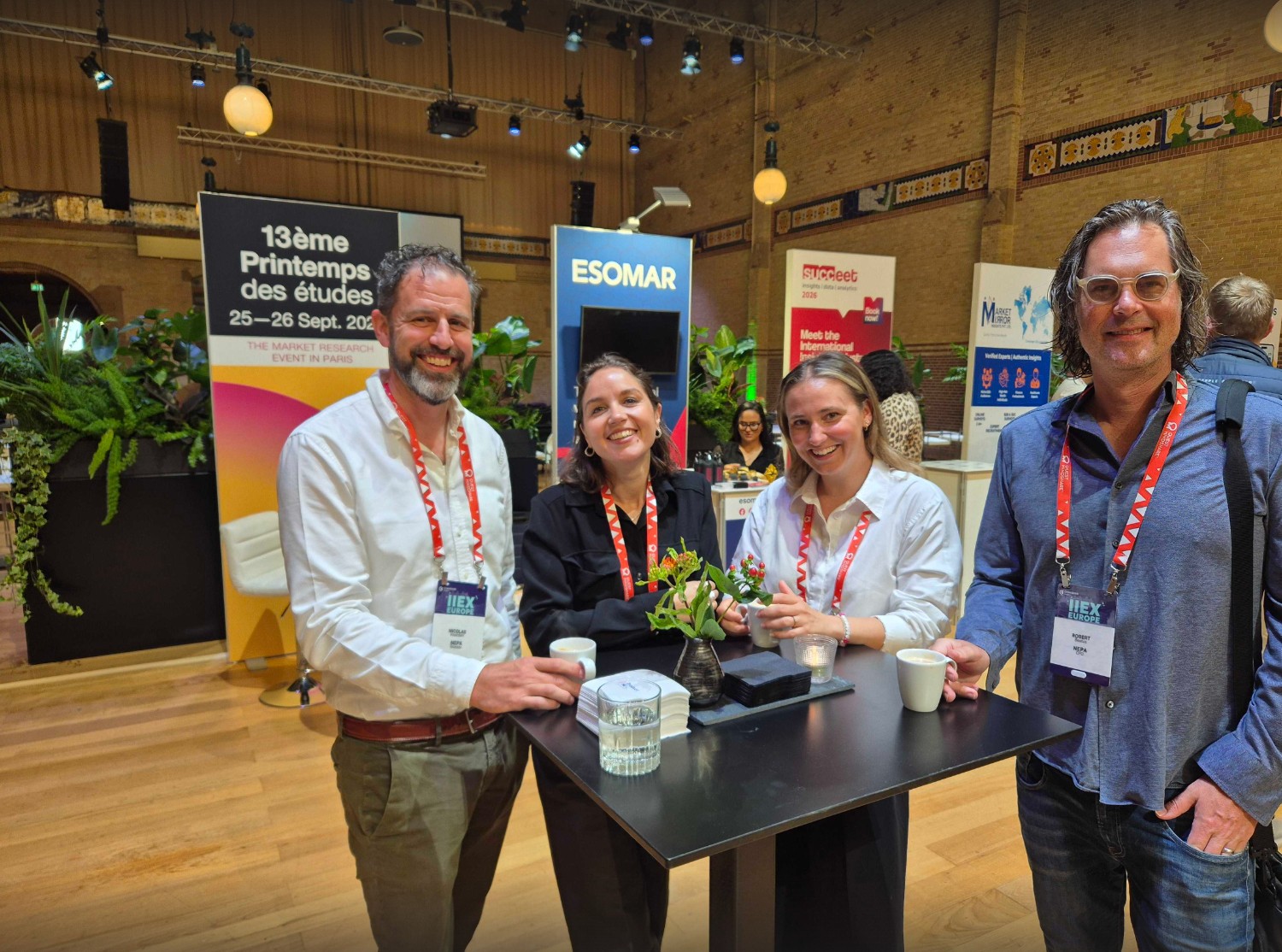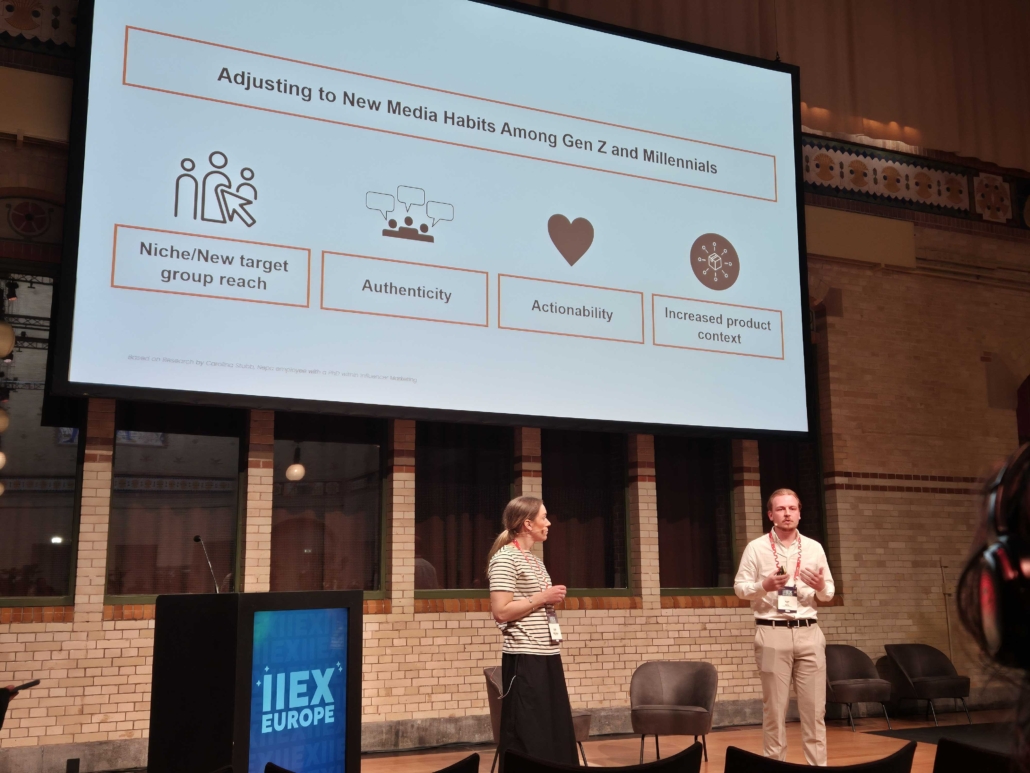Executive Summary: Get the key trends and takeaways in under 2 minutes:
Key takeaways from IIEX Europe 2025
AI everywhere – but not everything
AI dominated the conference agenda and is now seen as an essential tool for insight generation, innovation support, and—more than ever—helping bring insights to life for clients. The core message from IIEX: experiment with AI now; don’t wait for the “perfect” case. However, AI isn’t creative or strategic on its own—it should be seen as a collaborator, not a replacement for human judgement.
Three distinct areas of AI application
The conference showcased AI trends across three areas:
- Synthetic data and personas are enabling rapid, scalable research, although they can lack the nuance of real human behaviour.
- Qualitative research at scale, powered by conversational and multi-modal AI, is delivering more engaging, authentic feedback.
- Agentic AI and automation are emerging for storytelling and insight activation—helping organisations better share, visualise, and activate insights, but still relying on human creativity and oversight.
Bringing insights to life
A major trend this year was not just using AI to conduct research, but to activate and communicate insights more effectively within client organisations. Storytelling, sharing, and internal engagement are increasingly critical—especially for larger tracking clients. The consensus at IIEX: human–AI collaboration is key to making insights resonate and drive real action.
Evolving brand tracking
Brands are demanding future-proof, cross-market tracking solutions with unified frameworks and KPIs directly linked to business growth. The most forward-thinking brands are using new data sources and innovative sampling methods to make tracking more actionable and representative.
Empathy and emotional insight matter
Successful innovation starts by understanding and addressing emotional needs—not just functional benefits. “Innovation without empathy becomes invasion” was a recurring theme, underlining that empathy is as important as data.
Rethinking research methods
While traditional surveys (including the Likert scale) remain a mainstay in the industry, IIEX highlighted a growing interest in supplementing these with more conversational, emotion-capturing formats. Methods such as video interviews and prototype testing are helping researchers get closer to real consumer behaviour and emotion—adding richness and depth to the data.
Real-world validation
There’s a strong push across the industry to test insights in realistic environments—whether through behavioural observation, virtual worlds, or in-context prototyping—to bridge the gap between what consumers say and what they actually do. While this is an area of rapid innovation, the adoption of these methods varies across organisations.
The limits (and laughter) of AI
A memorable moment was the “Keen as Mustard & Flora” session, which included a demonstration of asking ChatGPT to create a conference presentation. The result? A confidently nonsensical infographic titled “Walking Alone at Night: A Perspective on Women’s Safety”—which had nothing to do with the topic. This highlighted both the promise and limitations of generative AI: helpful for outlining, but still needing human guidance for compelling storytelling.
Full Report: IIEX Europe 2025
For those who want the complete picture—including examples, quotes, and actionable insights—here’s our full write-up from the conference:
In mid-June 2025, insight professionals from across the globe converged at IIEX Europe in Amsterdam—one of the industry’s most future-focused gatherings. Over two days (17–18 June), the conference buzzed with ideas on where research and marketing are headed next. Nepa was there in full force, with a highlight being Nepa’s own Elias Olai sharing the stage with Louise Rimbäck of Cure Media to tackle one of marketing’s thorniest questions: How do you measure the real impact of influencer marketing on brand growth? Their session on assessing influencer marketing’s true effect—and turning those influencer hits into lasting brand results—set an early tone for the event. That tone was clear: experimentation, human-centric innovation, and smart AI integration are driving the future of insights.
AI takes centre stage at IIEX Europe 2025– as a collaborator, not a replacement
If there was a single thread running through IIEX Europe 2025, it was AI everywhere. More than half the sessions had “AI” in the title, with discussions covering generative tools, automation, and machine learning-driven analytics. The message? Don’t wait for the “perfect” use case—start experimenting with AI now. AI is increasingly seen as a tool to enhance insight generation and streamline workflows, not as a replacement for human expertise.
Crucially, presenters underscored AI’s limitations. While today’s AI can process huge datasets and help structure narratives, it isn’t a strategist or a true creative. AI can generate options but still needs human judgement to select and validate the right ones. “Know the limits—AI isn’t strategic or creative. It needs human expertise to guide and validate the output,” as one recap emphasised. The consensus: AI is a collaborator—a powerful assistant, but not an autonomous decision-maker.
Several practical case studies reinforced this view. For example, Swarovski’s insights team showed how AI is supporting their communications research, driving tangible results. The takeaway was clear: AI has moved from buzzword to everyday tool—a helper that makes insight work sharper and more efficient, but always alongside human expertise.
Bringing insights to life for clients
A significant trend this year was the focus on using AI not just for more efficient research, but for activating insights across entire organisations. AI-powered tools are helping to craft stories, visuals, and video summaries—making insights more engaging and actionable. This is especially relevant for large tracking clients, where the goal is to move beyond the numbers and embed research-driven actions throughout the business.
For teams focused on business impact, the conversation has shifted: it’s not just about doing research differently, but about ensuring that insights are communicated, understood, and acted upon.
Watch our reel from IIEX
Three distinct areas of AI application
AI use cases highlighted at IIEX fell into three main categories:
- Synthetic data & personas: Virtual research subjects, either fully synthetic or based on benchmarked models (e.g., Brainsuit, Heineken’s synthetic personas), offering speed and scale but less nuance.
- Qualitative research at scale: Leveraging conversational AI and multi-modal tools (video, voice, chatbots) to collect rich, authentic feedback at scale (e.g., Bolt Insight, Conveo).
- Agentic AI and automated insight activation: Experimental approaches using AI to automate storytelling, generate infographics, or create “talking head” videos (e.g., Market Logic, Enlyta), with human review essential for effective outputs.
A personal reflection from the conference: while “qual at scale” with AI is delivering interesting results, AI-generated storytelling is still developing—but could become a powerful way to activate insights in the future.
Future-proof brand tracking: one source of truth, aligned to growth
Brand tracking was another hot topic. With markets and data becoming more fragmented, brands are seeking unified, cross-market tracking systems that serve as a single source of truth. The call at IIEX: future-proof tracking frameworks, standardised metrics, and KPIs tied directly to business growth.
Speakers stressed that modern tracking should go beyond generating scores—it should inform strategy and drive marketing effectiveness. Brands like IKEA were mentioned as examples of moving towards centralised, in-house frameworks, but this was the exception rather than the rule.
Increasingly, companies are combining new data sources (digital, in-store, behavioural analytics) and innovative sampling to boost feedback quality and coverage. The greatest value comes when these insights drive business action, guided by clear frameworks and engaging storytelling.
Innovation with empathy: emotion over function at IIEX Europe 2025
IIEX 2025 wasn’t all about tech. A recurring theme was the need for empathy and emotional connection in innovation. “Innovation without empathy becomes invasion” captured the sentiment perfectly: real innovation solves real human needs—not just functional challenges.
Salma Alaa Nosseir from Henkel, for example, described a design thinking approach that involves consumers early in product development, grounding innovation in actual emotional needs and context. Similarly, Cheerkim Keo from Foot Locker demonstrated the value of human connection and cultural immersion, even in a digital world. The message: empathy and emotional insight are critical to meaningful innovation, whether developing products or crafting campaigns.
Rethinking research at IIEX Europe 2025: more conversations, richer data
IIEX speakers were candid about the need to update research methods. While traditional surveys (including Likert scales) remain vital tools, the industry is actively exploring new, more conversational and emotion-capturing formats to complement these methods. Video interviews, ranking exercises, and prototype testing are helping to capture more nuanced, experiential data, giving researchers deeper insights into real consumer behaviour.
The goal: combine the consistency and scale of traditional surveys with the richness and authenticity of newer approaches—so research feels more like a conversation and less like a checklist.
Testing insights in the wild: the rise of real-world validation
Another key trend discussed was the importance of validating research findings in real-world or simulated contexts. Whether through VR, AI-generated personas, or in-person ethnography, the push is to bridge the gap between stated behaviour and real actions. Examples included 360° immersion studies and virtual testing on platforms like Roblox. These are areas of rapid innovation, but adoption varies by company and market.
Bringing research to life: Storytelling, sharing, and internal engagement
A major takeaway: the future is not just generating insights, but making them engaging and actionable for all stakeholders. AI can help create video summaries, infographics, and internal comms—but the most powerful outcomes come from blending human creativity with AI support.
The Keen as Mustard & Flora session demonstrated how AI and human teams can collaborate on storyboards and presentations. The presenters gave AI (ChatGPT) free rein to create a conference presentation—with hilarious results: a confidently nonsensical infographic about “Walking Alone at Night: A Perspective on Women’s Safety,” which had nothing to do with the topic. This underlined both the potential and the current limits of generative AI—helpful for drafts and outlines, but still needing human guidance for nuance, creativity, and context.
Conclusion IIEX Europe 2025: Embracing experimentation, human-centred innovation, and thoughtful AI
As IIEX Europe 2025 wrapped up, one thing was clear: the future of research and marketing is bold, balanced, and collaborative. New technologies like AI, VR, and automation will continue to change how we work, but the most effective teams will blend these tools with empathy, real-world validation, and actionable storytelling.
For Nepa, it’s about adopting the best of what’s emerging—always grounded in human insight and business impact. The next chapter in innovation belongs to those who are willing to experiment, connect deeply with real people, and harness technology as an enabler—not a replacement—for meaningful insight.
Questions or reflections on the trends from IIEX Europe? Get in touch with us here!
Sources:
Nicolas Westdahl (Nepa) – IIEX Europe 2025 Day 1 Highlights
Nepa LinkedIn – Announcement of Elias Olai & Louise Rimbäck’s IIEX session
Cure Media LinkedIn – IIEX Europe influencer marketing session preview
Alexander Shmelkov – IIEX Europe 2025 Reflections (LinkedIn post)
Rashed Chowdhury (Orchard) – “AI and the big story for me at IIEX Europe”
GreenBook Podcast Recap – “From AI Insights to Virtual Worlds: Unpacking IIEX Europe”
DVJ Insights – IIEX Europe event description (Amsterdam, June 17–18, 2025)
Nepa LinkedIn – If Insurance case study on cross-market campaign measurement
Discuss.io – Blog on IIEX EU and launch of 360 Immersion VR research tool
IIEX Europe 2025 presentation (Maris Tuvikene, conference slides)
Published on: 27TH JUN 2025

